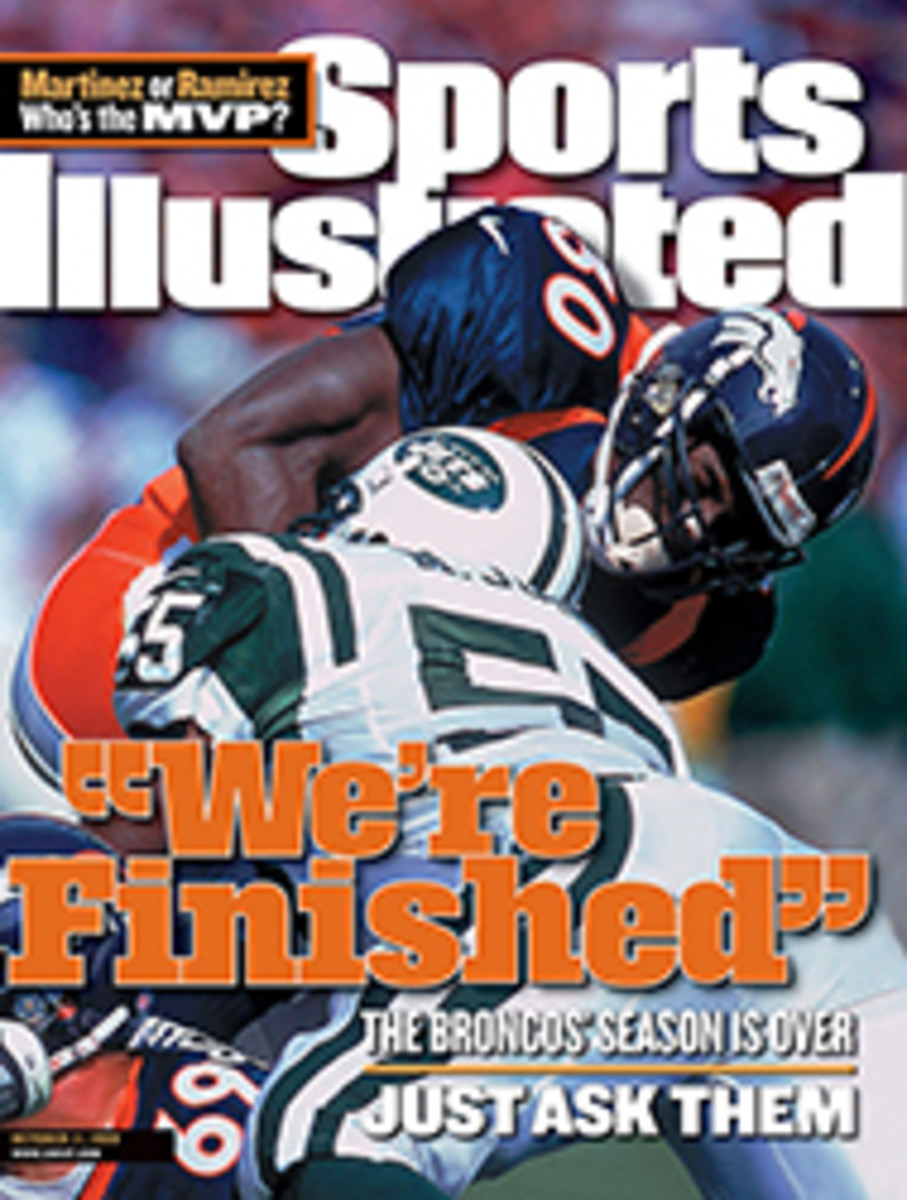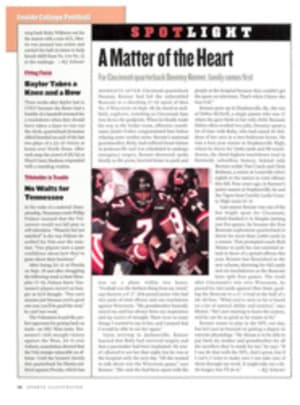
Inside Baseball
ECONOMY DRIVE
The Reds' near-miss season was no blueprint for low-revenue
success
At last year's winter meetings, Reds general manager Jim Bowden
took time out from building a team with a paltry $33 million
payroll to lobby baseball officials with an off-the-wall
solution to the game's economic inequities: realignment along
fiscal lines. High-revenue clubs like the Braves and the Astros
would compete against one another, with separate, lower-rent
divisions for Cincinnati and its shallow-pocketed brethren.
Did the Reds' improbable run--which ended Monday night in a 5-0
loss to the Mets in a one-game playoff for the National League
wild card--cause Bowden to rethink his proposal? Has Cincinnati,
whose 96 wins were its most since 1976, provided a model for
other low-payroll teams to follow? "Absolutely not," Bowden said
last Saturday. "We're an aberration."
Still, Cincinnati was a deserving presence in a three-team race
that in the end took a hard left turn from the norm. How to
explain the Astros' and Mets' reaching mid-September on
near-100-win paces, only to trip all over themselves in the
homestretch? How to explain the Reds, baseball's best road team,
with a 51-30 record, dropping two of three to the lowly Brewers
in Milwaukee on the season's final weekend? How to explain
Cincinnati's bullpen, which had been tied with Atlanta's for the
major league lead with 33 wins and led the bigs with a 3.29 ERA,
collapsing in the two losses?
In the end, how to explain the Reds' presence in the race at
all? After a Sept. 19 loss to the Pirates, Cincinnati was 31/2
games behind the Central Division-leading Astros and four behind
the wild-card-leading Mets. It seemed that the little-engine
Reds had finally run out of steam. But Cincinnati won seven of
its next nine games to tie Houston and build a two-game lead
over bumbling New York with three to play.
The Reds climbed back into the race the same way they had won
all season: by riding their few high-priced veterans and getting
key contributions from a cast of young stars-in-the-making. Greg
Vaughn, whose $5.6 million salary makes him the highest-paid
Cincinnati player, hammered three homers and drove in 10 runs in
that nine-game stretch. Veteran starters Juan Guzman, Pete
Harnisch and Denny Neagle went a combined 3-0 with a 1.29 ERA.
Cincinnati's less experienced performers also came up big down
the stretch. Second baseman Pokey Reese, 26, continued his
surprisingly strong offensive season by hitting .302 in
September and clubbing a 12th-inning, three-run homer to beat
the Cardinals on Sept. 26 and give the Reds a one-game wild-card
lead. First baseman Sean Casey awoke from a second-half slumber
and hit .313 with 16 RBIs for the month.
"If you have a lot of young players who come together at the
same time, and you don't have too many free agents, and
everything is timed just right, it can be done," says Bowden of
trying to win without a megabucks roster. "But you can't plan on
eight guys without significant experience having the success
they're having now."
Bowden isn't optimistic that the Reds' giddy run can be repeated
in 2000. With Vaughn a free agent and young stars such as Reese
and outfielders Dmitri Young and Mike Cameron eligible for
arbitration this off-season, Bowden estimates it would cost at
least $50 million to keep the team intact. "Revenue will
determine how much of this team we bring back," says Bowden.
"But don't expect anyone to win next year with a $30 million
payroll."
Top of the Atlanta Lineup
THE BRAVES' ONE-TWO PUNCH
Ask about the Braves' MVP poster boy, Chipper Jones, and Atlanta
manager Bobby Cox nods, smiles and says all the right things.
Mention leftfielder Gerald Williams and second baseman Bret
Boone, and Cox really gets excited. "Fantastic," he says. "If
anyone realized how important those two have been...."
Last season, with injury-hobbled shortstop Walt Weiss leading
off and the lackluster second base platoon of Keith Lockhart and
Tony Graffanino batting second, the Braves got 23 stolen bases
and 209 runs from the top two lineup spots, ranking eighth in
the National League in the latter category. This year those
numbers jumped to 48 and 222, respectively. Says Williams, who
hit .280 after moving into the leadoff spot for good on Aug. 5,
"I'll see what a pitcher has, how he's throwing, what the
movement's like. Then I'll tell Bret, and he'll get more
information. We process it and provide it to the big boys."
By big boys Williams means third baseman Chipper Jones,
rightfielder Brian Jordan and centerfielder Andruw Jones, who
combined for 94 home runs and 309 RBIs. But Williams and Boone
have contributed more than information. After batting seventh
for much of his first seven big league seasons, Boone has
transformed his game. Last year he drove in 95 runs but scored
only 76. This season, he had 63 RBIs and 103 runs. That swing,
coupled with Williams's 76 runs and 19 stolen bases,
jump-started the Braves' attack.
Atlanta lost slugging first baseman Andres Galarraga--who last
February was found to have cancer--before the season and lost
catcher Javy Lopez (torn anterior cruciate ligament) on July 24.
In addition Jordan played the second half of the season with a
nagging hand injury. Yet the Braves still finished with 840
runs, 14 more than in 1998. "With all the injuries, people
wonder how we've done so well," says Cox. "Look at those two for
a good answer."
Minority Manager
SPENCER FOR HIRE?
Tom Spencer has long dreamed of managing in the majors. That's
why he has stuck around the game for so long--11 years as a
minor league player, three years as a first base coach with the
Indians and the Mets, three seasons as a coach in the minors and
eight seasons as a minor league skipper. In late September,
Spencer called commissioner Bud Selig to find out if, as an
African-American, he was among baseball's recognized pool of
minority candidates for managerial openings. (Since April the
commissioner's office has required clubs to submit lists of all
candidates under consideration for managerial and certain
front-office positions as a way of ensuring minority
representation.) "Bud told me I wasn't listed," says Spencer,
48, who this season led the Charlotte Knights, a White Sox
affiliate, to the International League title. But Spencer says
he was assured that he would not be overlooked in the future.
A winner of three league titles in his eight seasons as a minor
league manager, Spencer has been interviewed for just one big
league managerial post, with the White Sox two years back. It's
frustrating, he says, to hear the term minority candidate and
then read the same old list of names--Braves hitting coach Don
Baylor, Yankees coaches Chris Chambliss and Willie Randolph,
Reds bench coach Ken Griffey Sr., Padres first base coach Davey
Lopes.
"I hate to complain," says Spencer, "but I think it hurts that
I'm not a, quote, celebrity name. I've proven that I can manage
at the highest level." On Sept. 29 Spencer resigned from the
White Sox organization when the front office said it could not
accommodate his request to be added to the major league staff or
be given a roving position that would allow him to spend more
time at his Tucson home.
Spencer is extremely light skinned and, even he concedes, may
not be widely recognized as a minority. "But what difference
does it make?" he asks. "Black, white, red, purple--if you can
manage, you can manage. I can manage."
Anaheim's Bavasi Departs
ANGELS HAD BETTER DUCK
Last Friday, Angels general manager Bill Bavasi, a respected
baseball man with six years on the job, resigned. Although most
everyone in the game agrees that Anaheim's disastrous 70-92
season was a result of injuries and poor chemistry, not a lack of
talent, Angels president Tony Tavares (also chairman of the NHL's
Mighty Ducks) is planning to gut a club that finished three games
out of first in the American League West only a year ago.
Shortstop Gary DiSarcina and outfielders Tim Salmon, Jim Edmonds
and Garret Anderson could well be traded, and lefthander Chuck
Finley could leave as a free agent. Bavasi was an ardent
supporter of his players; Tavares--who in addition to seeking a
successor for Bavasi is also looking for a manager to replace
Terry Collins, who resigned last month--is not. "We obviously
have some fine players," Tavares says, "but I don't know if they
have any idea what a team is. Someone told me you can't trade 25
players. I said, 'Why not?'"
In 1997 Tavares, then president of the Ducks, oversaw the firing
of coach Ron Wilson just after Wilson took Anaheim to its first
playoff appearance. Wilson, like Bavasi, wanted to build on many
of the players Anaheim already had. Tavares preferred to add
more younger players. In 1996-97 the Ducks finished 36-33-13.
The next two years they were 26-43-13 and 35-34-13.
For complete scores and stats, plus Tom Verducci's mailbag, go
to cnnsi.com/baseball.
COLOR PHOTO: STEPHEN GREEN Will free agent Vaughn, whose 45 homers and 118 RBIs sparked Cincy's charge, be back in 2000?
COLOR PHOTO: CHUCK SOLOMON
Home Run Standouts
Despite their big numbers, McGwire and Sosa aren't that far
ahead of the crowd
Sure, Mark McGwire (above) and Sammy Sosa finished one-two in
another record-breaking home run race, but when measured against
past home run champs, Big Mac and Sammy were ordinary--at least
by one man's calculation. The Home Run Power Ratio (HRPR), a
statistic developed by writer Matt Baron of Oak Park, Ill.,
compares the number of at bats per home run for a player to the
frequency of homers for all other players in his league (or,
since interleague play began in 1997, to all other players in
the majors). McGwire had 65 home runs in 521 at bats this year,
or a homer every 8.02 at bats; the rest of the majors hit 5,463
homers in 166,615 at bats, or one every 30.50 at bats. Dividing
30.50 by 8.02 yields an HRPR of 3.80. (Sosa, with 63 homers in
625 at bats, had a 3.07.) Over the past 50 years the average
HRPR for home run champs has been 3.26. The alltime king was
Babe Ruth, who had 11 of the top 14 HRPRs since 1918. Here are
the top 10 HRPR full seasons for the past half century, as well
as the best single-season performances in each of the last eight
decades.
TOP 10 HRPR PERFORMANCES SINCE 1950
PLAYER, TEAM YEAR HR HRPR
1. Mike Schmidt, Phillies 1980 48 4.82
2. Dave Kingman, Mets 1976 37* 4.74
3. Hank Aaron, Braves 1971 47* 4.66
4. Willie Stargell, Pirates 1971 48 4.61
5. Mark McGwire, Cardinals 1998 70 4.59
6. Willie McCovey, Giants 1968 36 4.38
7. Dave Kingman, Cubs 1979 48 4.29
8. Kevin Mitchell, Giants 1989 47 4.29
9. Willie McCovey, Giants 1969 45 4.20
10. Willie Mays, Giants 1965 52 4.04
TOP HRPR PERFORMANCES BY DECADE
AMERICAN LEAGUE
DECADE PLAYER, TEAM YEAR HR HRPR
1920s Babe Ruth, Yankees 1920 54 15.54
1930s Babe Ruth, Yankees 1931 46 7.01
1940s Hank Greenberg, Tigers 1946 44 5.76
1950s Mickey Mantle, Yankees 1956 52 3.96
1960s Mickey Mantle, Yankees 1961 54* 3.86
1970s Dick Allen, White Sox 1972 37 3.93
1980s Reggie Jackson, Yankees 1980 41 3.42
1990s Cecil Fielder, Tigers 1990 51 3.89
NATIONAL LEAGUE
DECADE PLAYER, TEAM YEAR HR HRPR
1920s Cy Williams, Phillies 1923 41 6.58
1930s Mel Ott, Giants 1931 29* 5.34
1940s Mel Ott, Giants 1944 26* 5.05
1950s Ralph Kiner, Pirates 1950 47 3.42
1960s Willie McCovey, Giants 1968 36 4.38
1970s Dave Kingman, Mets 1976 37* 4.74
1980s Mike Schmidt, Phillies 1980 48 4.82
1990s Mark McGwire, Cardinals 1998 70 4.59
*Did not lead league in home runs.

